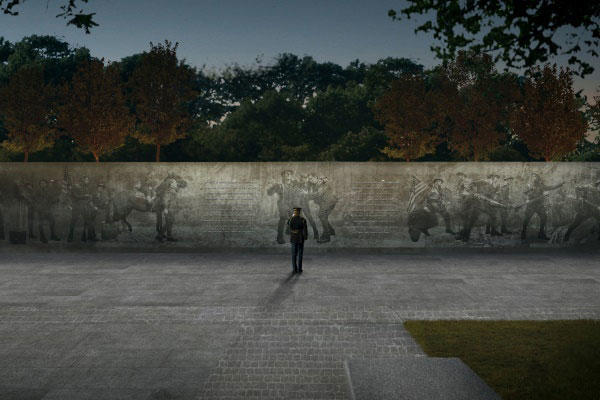A design called "The Weight of Sacrifice" featuring a commemorative wall and open space for 28 trees has been chosen for the new World War I Memorial to be constructed about a block from the White House.
Following years of debate over site location and funding, the design concept by 25-year-old architect-in-training Joseph Weishaar of Chicago and collaborating sculptor Sabin Howard of New York City on Monday was picked as the winner of the international design competition over four other finalists by the U.S. World War One Centennial Commission.
The design is still a work in progress. Quotations have yet to be chosen to be included in the frieze and bas relief on the commemorative wall depicting battle scenes. The estimated cost for the project is $30 to $35 million, which will come entirely from private donations.
The memorial will honor the 4.7 million Americans who served in uniform during the "Great War," the 2 million of them who deployed overseas, and the 116,516 who died in what some at the time called "the war to end all wars."
"Those five million Americans who served in uniform during World War I literally changed the world," said Robert Dalessandro, the commission’s chairman. "This new landmark in our nation's capital will be a worthy expression of their great legacy."
The memorial was scheduled to be dedicated on Nov. 11, 2018, which is the centennial anniversary of the eleventh hour, of the eleventh day, of the eleventh month when World War I ended in what became known as "Armistice Day," and later became Veterans Day.
The war officially ended on June 28, 1919, with the Treaty of Versailles, and in November 1919, President Woodrow Wilson proclaimed Nov. 11 as the first commemoration of Armistice Day.
"To us in America, the reflections of Armistice Day will be filled with solemn pride in the heroism of those who died in the country’s service and with gratitude for the victory," Wilson said at the time, "both because of the thing from which it has freed us and because of the opportunity it has given America to show her sympathy with peace and justice in the councils of the nations."
The site at Pennsylvania Ave. and 14th St. NW, across from the historic Willard Hotel, where Abraham Lincoln stayed before his inauguration, is now a small park honoring Gen. John J. "Black Jack" Pershing, "General of the Armies" and commander of the "Allied Expeditionary Force" in World War I.
The site now includes a sunken space that served as a reflecting pool and a small ice skating rink in winter but fell into disuse about a decade ago.
Local officials and federal legislation had blocked use of a site on the National Mall for the new memorial. The commission had initially intended to "rededicate" the current site on the Mall of the District of Columbia World War I Memorial honoring those from the District who died World War I.
"World War I is very much a forgotten war in this country" but "all of the conflicts that we are engaged in today -- they all trace a straight line to World War I" which overthrew monarchs and redrew the map of the world, said Edward Fountain, a Centennial Commissioner and general counsel to the American Battle Monuments Commission.
In a C-Span interview earlier this month, Fountain said, "We didn’t have a national war memorial until we built the Vietnam Memorial in the 1980s. Since then, we’ve been working backwards -- the Korean War Memorial and then World War II." He added, "This is the last best opportunity to educate the American people about this war."
-- Richard Sisk can be reached at Richard.Sisk@Military.com.






























